m (→Decline) |
mNo edit summary |
||
| Line 4: | Line 4: | ||
==Decline== |
==Decline== |
||
| − | During the Third Era the Nords were still devout followers of their own Pantheon, with the Nords of [[Bruma]] even refusing to attend sermons of the Nine in favor of their own gods.<ref>''[[Guide to Bruma]]''</ref><ref>Dialogue with [[Arentus Falvius]]</ref><ref>Dialogue with [[Cirroc]]</ref><ref>Dialogue with [[Isa Raman]]</ref> On the isle of [[Solstheim]], a dedicated following to Kyne existed, known as the [[Fryse Hag]]s.<ref>"[[Generic Dialogue (Bloodmoon)|fryse hags]]" dialogue topic in {{Bloodmoon}}</ref> These female Nords were unaccepting of anyone not part of their order, and would engage in combat with them.<ref>Events of {{Bloodmoon}}</ref> |
+ | During the Third Era the Nords were still devout followers of their own Pantheon, with the Nords of [[Bruma]] even refusing to attend sermons of the Nine in favor of their own gods.<ref>''[[Guide to Bruma]]''</ref><ref>Dialogue with [[Arentus Falvius]]</ref><ref>Dialogue with [[Cirroc]]</ref><ref>Dialogue with [[Isa Raman]]</ref> On the isle of [[Solstheim]], a dedicated following to Kyne existed, known as the [[Fryse Hag]]s.<ref>"[[Generic Dialogue (Bloodmoon)|fryse hags]]" dialogue topic in {{Bloodmoon|!}}</ref> These female Nords were unaccepting of anyone not part of their order, and would engage in combat with them.<ref>Events of {{Bloodmoon}}{{fact}}</ref> |
| − | In contrast to the Third Era, sometime during the Fourth Era worship of the Nordic Pantheon had begun to decline, with most of Skyrim instead worshipping the Imperial |
+ | In contrast to the Third Era, sometime during the Fourth Era worship of the Nordic Pantheon had begun to decline, with most of Skyrim instead worshipping the Imperial Divines by [[4E 201]].<ref>Dialogue with [[Froki Whetted-Blade]]</ref><ref>Events of {{Skyrim}}{{fact}}</ref> However, mention of the Nordic gods still formed a part of common Nord expressions.<ref>Quotes from [[Bandits (Skyrim)|Bandits]] during combat</ref> The only Nord known to have still worshipped one of the Nordic gods was [[Froki Whetted-Blade]], a devout follower of Kyne.<ref>Events of "[[Kyne's Sacred Trials]]"</ref> |
==Revered and worshipped gods== |
==Revered and worshipped gods== |
||
Revision as of 15:01, 15 March 2020
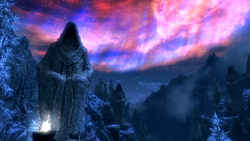
Sovngarde, the Nordic afterlife.
- Main article: Pantheons of Tamriel
- Not to be confused with Ancient Nordic Pantheon.
The Nordic Pantheon is the main religion of the Nordic people. St. Alessia merged this pantheon and the Aldmeri Pantheon to create the religion of the Eight Divines.[1]
Decline
During the Third Era the Nords were still devout followers of their own Pantheon, with the Nords of Bruma even refusing to attend sermons of the Nine in favor of their own gods.[2][3][4][5] On the isle of Solstheim, a dedicated following to Kyne existed, known as the Fryse Hags.[6] These female Nords were unaccepting of anyone not part of their order, and would engage in combat with them.[7]
In contrast to the Third Era, sometime during the Fourth Era worship of the Nordic Pantheon had begun to decline, with most of Skyrim instead worshipping the Imperial Divines by 4E 201.[8][9] However, mention of the Nordic gods still formed a part of common Nord expressions.[10] The only Nord known to have still worshipped one of the Nordic gods was Froki Whetted-Blade, a devout follower of Kyne.[11]
Revered and worshipped gods
Shor
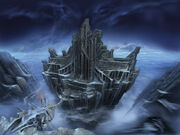
The Hall of Valor, Shor's palace in Sovngarde, the realm of Shor.
The "God of the Underworld" and the King of the Gods, Shor is the Nordic variant of the god Lorkhan, who took sides with Men after the creation of Nirn. He is the husband of the goddess Kyne[12] and the creator and ruler of Sovngarde, the Nordic afterlife.[13] Atmoran myths depict him as a bloodthirsty warrior-king who leads the Nords to victory over their Aldmeri oppressors time and again. Shor was the chief of the gods, until he was killed by the Elven Gods.[12] These gods ripped out his heart and flung it across the world, with Red Mountain forming where it landed.[14]
If Nords are slain in battle, their souls find themselves in Sovngarde, the realm of Shor. There their spirits feast, sing and spar within the Hall of Valor at Shor's side in a state of self-contained euphoria.[13] The souls of the heroes remain in Sovngarde until they ride out one last time with Shor during The Last War, where they will show their final, best worth.[13]
Shor was not directly included in the pantheon of the Eight Divines, but was instead replaced by Shezarr but was still represented in a way acceptable to some Nords as "the spirit behind all human undertaking" in the Cyrodilic pantheon.[1] Shor, and Shezarr, are suspected to be the same entity as Lorkhan.[12][14]
Tsun
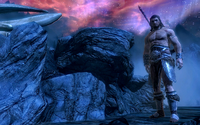
Tsun guarding the Hall of Valor.
The Nordic god of trials against adversity. He is brother to Stuhn and the shield-thane and died defending Shor from the Elven Gods.[12] Tsun was sent to Sovngarde and was ordered by Shor to guard the whalebone bridge that leads to entrance of the Hall of Valor.[15] From there, Tsun will tests all who wish to gain entry to the hall by fighting them in a trial by combat; only those who succeed in defeating him are able to gain entry.[15]
Stuhn
Stuhn, also known as the "God of Ransom," is the brother of Tsun and the Nordic precursor to Stendarr. Shield-thane of Shor, Stuhn was a warrior god that fought against the Aldmeri pantheon. He showed Men how to take, and the benefits of taking, prisoners of war.[12]
Kyne
Kyne, "Kiss at the End," warrior-widow to Shor and the Goddess of the Storm, is the Nordic variant of Kynareth. Kyne is a prominent Divine in Nord culture and is considered by some to be the actual leader of the Nord pantheon.[16] She is a favored god of warriors[16] and hunters.[12] Supporters of the Old Ways among the Nords dismiss Kynareth as a "pale shadow" of Kyne, and believe she is the one who leads souls of slain warriors to Sovngarde, the realm of her husband, Shor.[17] She is often called the Mother of Men, as Nords believe that the sky exhaled onto the land at the Throat of the World to form them.[17][18] Nords still refer to themselves as the "Sons and Daughters of Kyne" because of this belief.[19] She is also believed to be the mother of beasts, and she teaches hunters to respect the beasts they hunt.[12] As the Goddess of Storm, Kyne is called upon to bring rain and snow in dry times. She protects her faithful from the raging gales and blizzards that regularly sweep across the Skyrim expanse.[16]
She is also known for giving Paarthurnax, the lieutenant of Alduin, the task of teaching mortalkind the Thu'um, thus turning him and other dragons against Alduin.[20]
Kyne is said to be the mother of Morihaus, who was also known as Morihaus-Breath-of-Kyne[1] (and also possibly Pelinal Whitestrake)[21] who was famously the consort of Alessia[1] and father to the first Minotaur, Emperor Belharza.[22]
In Skyrim, Kyne's Token is given to warriors after completing Kyne's Sacred Trials[23]
Mara
In the Nordic Pantheon, Mara is a handmaiden of Kyne, worshipped as the Goddess of Love and Marriage. Mara is the most universal goddess, as she is found in nearly every religion.[12] In Skyrim, a pendant honoring her is worn to court lovers. Citizens know that a man or woman wearing one is seeking a candidate for marriage.[23]
Dibella
Popular god of the Nine Divines, Dibella is the Goddess of Beauty. In Cyrodiil, she has nearly a dozen different forms of worship, some devoted to women, some to artists and aesthetics, and others to erotic instruction.[12]
Orkey
Also known as Old Knocker, is a Nordic god of mortality and the Nordic variation of Arkay,[24] who was worshipped during the Aldmeri rule of Atmora. In those days, the Nords believed that they once had a lifespan similar to that of the Elves'.[12]
Nord legend states that Orkey, during the reign of High King Wulfharth in the First Era, summoned Alduin the world-eater to shorten the Nords' lives. King Wulfharth, who had become a boy, pleaded to Shor for help. Shor's own ghost then fought Alduin on the spirit plane. Shor was victorious and Orkey's folk, the Orcs, were ruined. Wulfharth, by watching this battle in the sky, learned how to use the thu'um to save his people. His effort, while successful, cost him his life.[14]
Alduin
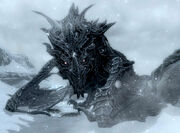
Alduin on the Throat of the World.
Also known as the 'World Eater'. Scholars debate whether Alduin is the name the Nords gave to Akatosh,[12][25] stating that Alduin and Akatosh are two completely different deities.[26] Alduin proclaimed himself to be the "First-Born of Akatosh"[23]
Alduin's sobriquet, the 'World Eater', comes from a myth that depicts him as a ravaging firestorm that entirely destroyed the previous world, which brought about the Dawn Era. This would explain why the Nords see him as both creator and harbinger of total destruction.[12]
Ysmir
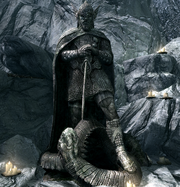
A statue of Ysmir (Talos).
Ysmir, "Dragon of the North," is one of the most important hero-gods of the Nords. Ysmir is the Nordic aspect of Talos.[12]
Ysmir is a title given to great heroes in Nord history, the first to be bestowed the title was King Wulfharth, he was said to have a Thu'um so powerful that he could not speak. He was given the title Ysmir for his zealotry against the Alessian Order.[14] Wulfharth encountered the god Orkey whilst being High King, he died when he used the Thu'um to save his people from being only able to live to six years old.[14]
Wulfharth was resurrected several times in history, the first was by Shor to fight and lead the invasion of Morrowind. He was killed at the Battle of Red Mountain by Indoril Nerevar or Vivec (it is not known exactly what happened to Wulfharth due to the Dragon Break).[14] He was resurrected again by Jorunn the Skald-King to help defend Skyrim against an Akaviri invasion, after the invasion was thwarted, he returned to Sovngarde.[27]
The Emperor Tiber Septim was able to withstand the voice of the Greybeards long enough to hear their prophecy and was then on called 'Ysmir' when they saw that he was a Dragonborn.[23] Tiber Septim eventually founded the Septim Empire and ushered in the Third Era.[28]
During the events that unfold in the Fourth Era, which can be seen in The Elder Scrolls V: Skyrim, after completing The Horn of Jurgen Windcaller, the Greybeards greet the Dragonborn in the dragon tongue with the words: "... Meyz nu Ysmir, Dovahsebrom..." which translates to: "... Come now Ysmir, Dragon of the North...."[23]
Other gods
- Herma-Mora, also known as the Woodland Man, is an ancient Atmoran demon who, at one time, nearly seduced the Nords into becoming Aldmer. Most of Ysgramor's myths are about escaping the wiles of old Herma-Mora.[12]
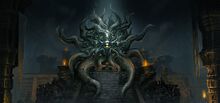
Herma-Mora concept art.
- Jhunal is the god of hermetic orders, runes, and the Nordic father of language and mathematics is Jhunal. After falling out of favor with the rest of this pantheon, he became Julianos of the Nine Divines. He is absent in modern Skyrim mythology.[12]
- Mauloch, an Orcish god, troubled the heirs of King Harald for a long time. Fled east after his defeat at the Battle of Dragon Wall, ca. 1E 660. His rage was said to fill the sky with his sulphurous hatred, later called the "Year of Winter in Summer."[12][24]
- Magnar is a god of dubious loyalty: a jarl trusted by Shor but distrusted by Kyne. During the wars against the gods of the elves, Magnar served as a scout. It is said that he falls at sunrise, only to resume his duties later on.[UL 1] A werewolf called Magnar Bearstorm, or Magnar the Child-Eater, shares the name of this god.[UL 2]
Trivia
- According to Michael Kirkbride and some Skyrim design documents, there were to be 4 "houses" of the gods which represented the different stages of the cycle of the Aurbis. There are the Dead Gods, who fought and died to bring about the new cycle; the Hearth Gods, who guard over the present cycle; the Testing Gods, who usher in the end of the cycle; and the Twilight Gods, who usher in the next cycle. The end of a cycle was supposed to be preceded by the Dragonborn God, a god that did not exist in the previous cycle but whose presence means that the current one is almost over. This has not been proven to be implemented in to the game fully and as such, may not be able to be taken as lore.[UL 3]
References
- ↑ 1.0 1.1 1.2 1.3 Shezarr and the Divines
- ↑ Guide to Bruma
- ↑ Dialogue with Arentus Falvius
- ↑ Dialogue with Cirroc
- ↑ Dialogue with Isa Raman
- ↑ "fryse hags" dialogue topic in Bloodmoon
- ↑ Events of The Elder Scrolls III: Bloodmoon[source?]
- ↑ Dialogue with Froki Whetted-Blade
- ↑ Events of The Elder Scrolls V: Skyrim[source?]
- ↑ Quotes from Bandits during combat
- ↑ Events of "Kyne's Sacred Trials"
- ↑ 12.00 12.01 12.02 12.03 12.04 12.05 12.06 12.07 12.08 12.09 12.10 12.11 12.12 12.13 12.14 12.15 Varieties of Faith in the Empire
- ↑ 13.0 13.1 13.2 Sovngarde, a Reexamination
- ↑ 14.0 14.1 14.2 14.3 14.4 14.5 Five Songs of King Wulfharth
- ↑ 15.0 15.1 Dialogue with Tsun
- ↑ 16.0 16.1 16.2 Goddess of Storm, Mother of Nords
- ↑ 17.0 17.1 Dialogue with Froki Whetted-Blade
- ↑ Children of the Sky
- ↑ Decree of Monument
- ↑ 7000 Steps Etchings
- ↑ The Song of Pelinal, Book V
- ↑ On Minotaurs
- ↑ 23.0 23.1 23.2 23.3 23.4 Events of The Elder Scrolls V: Skyrim
- ↑ 24.0 24.1 Varieties of Faith: The Nords
- ↑ The Alduin/Akatosh Dichotomy
- ↑ Alduin is Real
- ↑ Jorunn the Skald-King
- ↑ Brief History of the Empire, Book I
| Deities of Tamrielic races | |
|---|---|
| Imperial Pantheon | |
| Nordic Pantheon | |
| Altmeri Pantheon | |
| Bosmeri Pantheon | |
| Dunmeri Pantheon | |
| Redguard Pantheon | |
| Bretony Pantheon | |
| Khajiiti Pantheon | |
| Argonian Pantheon | |
| Ayleid Pantheon | |
| Kothri Pantheon | |
| Orcish Pantheon | |
| Reachfolk Pantheon | |
| Snow Elf Pantheon | |
